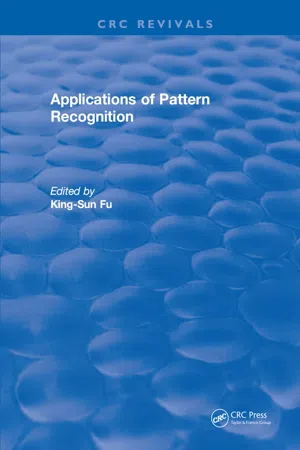
This is a test
- 284 pages
- English
- ePUB (mobile friendly)
- Available on iOS & Android
eBook - ePub
Applications of Pattern Recognition
Book details
Book preview
Table of contents
Citations
About This Book
This monograph is intended to cover several major applications of pattern recognition. After a brief introduction to pattern recognition in Chapter 1, the two major approaches, statistical approach and syntactic approach, are reviewed in Chapter 2, and 3, respectively. Other topics include the application of pattern recognition to seismic wave interpretation, to system reliability problems, to medical data analysis, as well as character and speech recognition.
Frequently asked questions
At the moment all of our mobile-responsive ePub books are available to download via the app. Most of our PDFs are also available to download and we're working on making the final remaining ones downloadable now. Learn more here.
Both plans give you full access to the library and all of Perlego’s features. The only differences are the price and subscription period: With the annual plan you’ll save around 30% compared to 12 months on the monthly plan.
We are an online textbook subscription service, where you can get access to an entire online library for less than the price of a single book per month. With over 1 million books across 1000+ topics, we’ve got you covered! Learn more here.
Look out for the read-aloud symbol on your next book to see if you can listen to it. The read-aloud tool reads text aloud for you, highlighting the text as it is being read. You can pause it, speed it up and slow it down. Learn more here.
Yes, you can access Applications of Pattern Recognition by King-Sun Fu in PDF and/or ePUB format, as well as other popular books in Computer Science & Computer Vision & Pattern Recognition. We have over one million books available in our catalogue for you to explore.
Information
Chapter 1
INTRODUCTION
K. S. Fu
TABLE OF CONTENTS
I. What is Pattern Recognition?
II. Approaches to Pattern Recognition
III. Basic Nonparametric Decision-Theoretic Classification Methods
A. Linear Discriminant Functions
B. Minimum Distance Classifier
C. Piecewise Linear Discriminant Functions (Nearest Neighbor Classification)
D. Polynomial Discriminant Functions
IV. Training in Linear Classifiers
V. Bayes (Parametric) Classification
VI. Cluster Analysis
VII. Bibliographical Remarks
References
I. What is Pattern Recognition?
The problem of pattern recognition usually denotes classification and/or description of a set of processes or events. The set of processes or events to be classified could be a set of physical objects or a set of more abstract ones such as mental states. The processes or events with some similar properties are grouped into a class. The total number of pattern classes in a particular problem is often determined by the particular application in mind. For example, consider the problem of English character recognition; we should have a problem of 26 classes. On the other hand, if we are interested in discriminating English characters from Russian characters, we have only a two-class problem. In some problems, the exact number of classes may not be known initially, and it may have to be determined from the observation of many representative patterns. In this case, we would like to detect the possibility of having new classes of patterns as we observe more and more patterns. Human beings perform the task of pattern recognition in almost every instant of their daily lives. Recently, scientists and engineers started to use machines for pattern recognition.
An intuitively appealing approach for pattern recognition is “template-matching”. In this case, a set of templates or prototypes, one for each pattern class, is stored in the machine. The input pattern (with unknown classification) is compared with the template of each class, and the classification is based on a preselected matching criterion or similarity criterion. In other words, if the input pattern matches the template of the ith pattern class better than it matches any other templates, then the input is classified as from the ith pattern class. Usually, for the simplicity of the machine, the templates are stored in their raw data form. This approach has been used for some existing printed-character recognizers and bank check readers. The disadvantage of the template-matching approach is that it is, sometimes, difficult to select a good template for each pattern class and to define a proper matching criterion. This difficulty is especially remarkable when large variations and distortions are expected in all the patterns belonging to one class. Recently, ...
Table of contents
- Cover
- Title Page
- Copyright Page
- Table of Contents
- Chapter 1 Introduction
- Chapter 2 Statistical Pattern Recognition
- Chapter 3 Syntactic Pattern Recognition
- Chapter 4 Application of Pattern Recognition to Remote Sensing
- Chapter 5 Application of Pattern Recognition to Seismic Wave Interpretation
- Chapter 6 Automatic Visual Inspection
- Chapter 7 Application of Pattern Recognition to Failure Detection and Analysis in Non-Digital Systems
- Chapter 8 Application of Pattern Recognition to Medical Data Analysis
- Chapter 9 Advances in Character Recognition
- Chapter 10 Automatic Speech Recognition
- Index